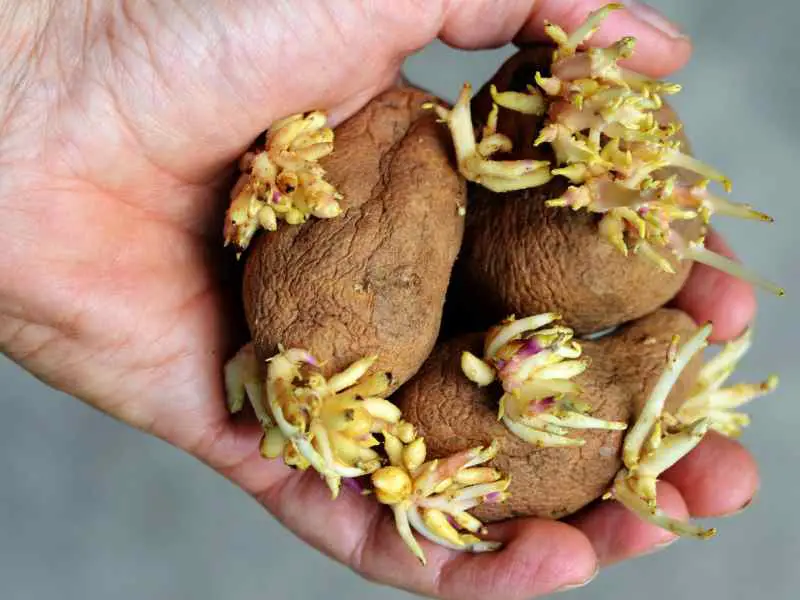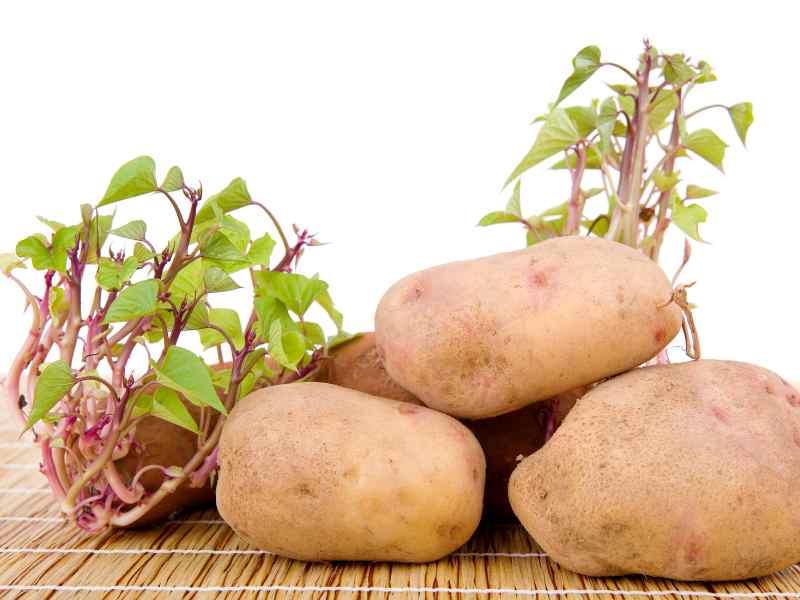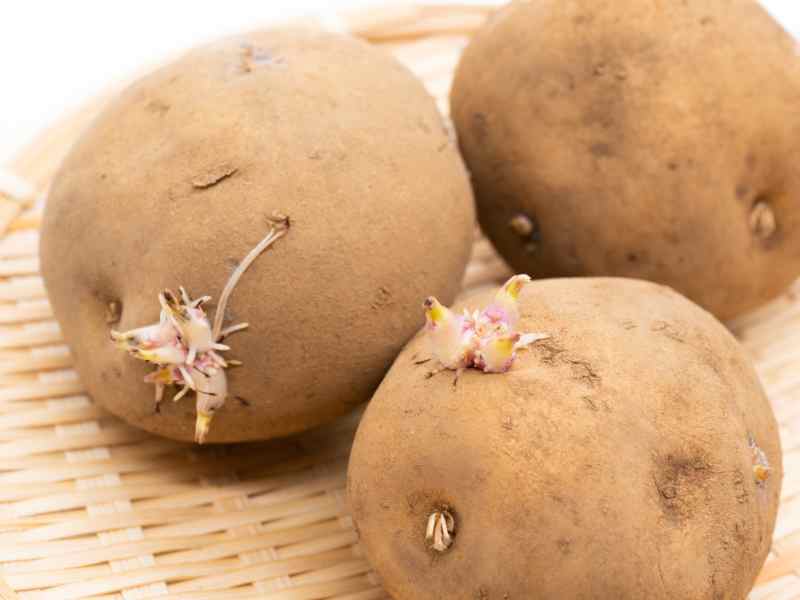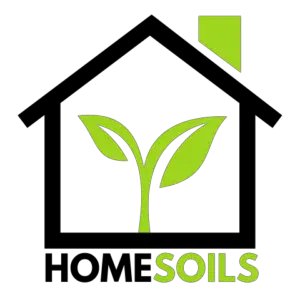Most of the time, people try to grow fruits and vegetables that are grown for commercial sale. However, there are a lot of plants, particularly vegetables, that are very prevalent in commercial markets but also have a big demand among home gardeners.

Among the many veggies, potatoes are one. These are quite popular among home gardeners due to their use and taste, while being quite widespread in the commercial markets due to their qualities. Potatoes are the main part of the diet almost all over the world.
The general perception of potatoes is that they are produced on a large scale for commercial purposes. But these potatoes are now successfully farmed on a rather large scale at home. You can easily start from fewer potatoes to the level of the full-year supply of potatoes in the kitchen.
So, whenever you would have potatoes at your home, in the spring season you would see that the potatoes are sprouting. You would have always wondered if I should try them. Let’s go for it because it is very easy and fun to do. Now you will learn growing potatoes sprouting.
Why plant potatoes?
There are many obvious reasons for why you should be going for the plantation of potatoes. First of all, everyone is aware of how nutritious potatoes are. One of the most widely cultivated crops worldwide is the potato. These are grown all over the world in accordance with the seasons and varieties. Rich and poor alike use it in a variety of ways all across the world.
For sure you would have been enjoying the potatoes in many forms and shapes. Ranging from fast food to cultural food items, you would see that potatoes are always there. It’s just a matter of how to cook, use, and digest.
Moreover, potatoes have great storage value. They can survive in a lot of conditions. The person who grows potatoes will always enjoy it and will observe the constant and full supply of required potatoes in the food and for the kitchen.
Why do potatoes sprout?
Sprouting of potatoes is the phase of these plants or you can say the phase of this vegetable to be propagated and to grow into a new plant. Like other vegetables, potatoes are grown and propagated through sprouted potatoes.
If you see that there are sprouts in the potatoes, you should know that these are ready to be sown in the soil. simply these sprouts are also known as tubers or the eyes. From these sprouts, the potatoes grow and finally bear more potatoes in the ground.
How to make potatoes sprout?
You might be wondering that here the case is that we have already sprouted potatoes. What if we have potatoes and we want to grow them? Yes, you can help potatoes sprout by storing them in a particular way.
If you want to sprout them store them in a light environment, which is warm and damp. The airflow should be good. This will prevent from rotting of potatoes and will help in sprouting. If you are able to get the potatoes from stores, some of these are specially stored for propagation as a seed.
Stored potatoes are often treated with the sprout inhibitor.
Growing potatoes sprouts

Now you would have learned and known that potatoes are in your league. You just need to make sure that the time is right when the potatoes are being planted, and the prerequisites are almost fulfilled to make sure the plantation and growth of potato sprouts.
Selection of sprouts/seed
There are two varieties of potatoes in the market. One is utilized for eating, and the other is used for cultivation. Grab the backups. To ensure a high rate of germination and yield, try to find certified potato seeds.
Choose your seed wisely now that you are aware of your options. The best months to plant potatoes are March, April, or May depending on the area of the plantation. The seeds must then be purchased in February. The potatoes would need to be stored for a few weeks before they would sprout.
When selecting or purchasing potato seeds, try to choose the ones that are smaller in size because larger potatoes have fewer buds that can sprout. potatoes can be chopped into larger pieces if you get any larger ones, as long as there are at least two sprouting buds on each piece.
If you already have the sprouted potatoes, then follow the same instructions. This will help you in laying a solid base for the plantation of the potatoes. Seeds will start sprouting soon. If you have already sprouted potatoes save them from the frost.
Selection of the soil
Since potatoes are a nutrient-dense vegetable, these plants require nutrition in order to thrive and produce fruitfully. Therefore, you should choose soil that is rich in nutrients. You can incorporate organically constituted material into the soil by tilling it together.
To meet the nutritional needs of the potatoes, you can also use blends of chemical fertilizers like ammonia and phosphorus. The organic composed matter can also increase the nutrition of the soil if it consists of chicken waste in it.
Maintain the soil’s pH between 6 and 7. You can measure the pH of the soil and adjust it by adding gypsum or limestone. Before planting the potatoes, keep the soil moist. So that the sprouted potatoes can prosper well.
Potatoes are typically grown in sunny areas. Therefore, you must choose a sunny area in the garden. You could also choose a spot that gets some sun. It’ll go smoothly.
To plant the potatoes in the garden, you must dig the trenches. Add the composite material or chemical fertilizers after excavating the trenches 8 to 13 cm deep. Additionally, look for weeds in the soil. Make sure the dirt is sufficient because you’ll need to cover the seeds and it’ll be needed again later.
Planting the potatoes sprouting

You can now plant the potato seeds because everything is prepared, trenches have been dug, and the soil has been maintained moist. The potatoes’ size may be reduced if they are planted too closely together. Therefore, space the potatoes 9 to 12 inches apart.
When planting, exercise caution to avoid breaking the sprouting seeds’ shoots. When sowing in the trenches, keep the sprouts facing upward. If the size of the potatoes is big, cut the potatoes. Make sure each piece has at least two buds or eyes.
After planting, cover the potato seeds with soil. There are two ways to add dirt to the plant. Making a hill add a significant amount of soil is a process known as hilling. Or you can add the soil along with the gradual growth of the potatoes plant. Potatoes grow well in the soil and gain good size.
Taking care of the potatoes
Potatoes are not tricky to take care of. You can easily make them grow steadily, but make sure they don’t face drought-like conditions. If nutrition, sunlight, water, and other basic requirement are met you are good to go.
Water requirements for the potatoes
Because they thrive in damp environments, potatoes enjoy being watered. However, be careful not to overwater the plants. Before watering the plants, you must first check the moisture level. You can check the moisture with the finger, if the upper inch of the land is moist then wait.
Sunlight requirements for the potatoes
Potatoes require sunlight to grow properly. They require five to six hours of sunlight exposure. If you have chosen a location where there is insufficient natural light, you must control it with artificial lighting settings.
Pests and diseases of the potatoes
Some of the typical potato illnesses may affect potatoes. Slugs, splitting, common scabs, and other things are examples of them. Additionally, the late blight and the Potato Cyst Nematode might harm these plants.
There may be local diseases or pests. Therefore, if you locate one, consult horticulture in the area to have the desired pests or diseases eliminated.
Harvesting the potatoes
Once the potatoes have reached maturity, you can harvest them. The presence of blossoms on plants will give you the signal. After that, you can begin harvesting. Be careful when tilling the soil to prevent damaging the potatoes, which may prevent them from being stored.
To store the potatoes, just don’t wash them. Simply allow the potatoes to dry in a shaded area before storing them in a cool, dark location. Boiling, roasting, and baking are just a few cooking methods that use potatoes. These are versatile because, when maintained properly, they maintain the firmness of the flesh.
In short, when someone listens to the name of the potatoes there always comes any dish which everyone has at least tried. And when keeping and seeing the potato sprouts most of us want to try planting it.
You can easily go for it. The scale of the plantation doesn’t matter. Just fulfill the requirements for the plantation and growth then enjoy the potatoes at home.

